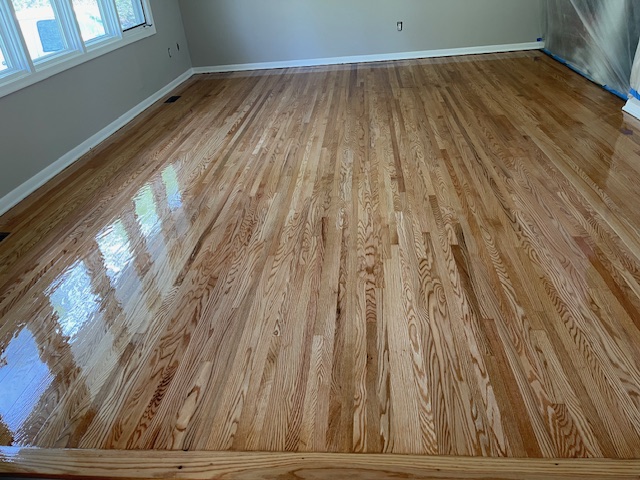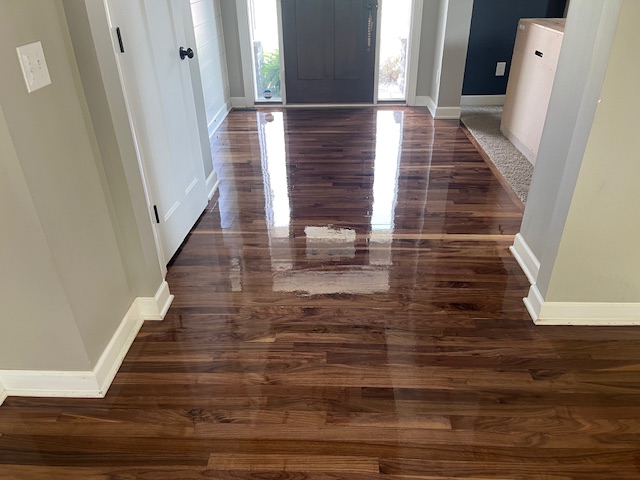Best Time To Refinish Hardwood Floors

The Best Time To Refinish Wood Floors: Timing and Benefits
When it comes to refinishing hardwood floors, timing is crucial. Many homeowners wonder about the best time to refinish their floors, and while it’s possible to do so at any point during the year, certain conditions can make refinishing during the warmer months the most ideal. In this article, we will explore the advantages of refinishing wood floors during the warmer, more humid months and why this time frame is optimal for preserving your floors and ensuring a high-quality finish. Additionally, we’ll dive into the benefits of performing the refinishing process when you can have your windows open and fresh air circulating through your home.
Why Warm Weather is Ideal for Hardwood Floor Refinishing
Hardwood floors are constantly reacting to environmental conditions. The wood expands and contracts in response to temperature and humidity levels, which is a natural and unavoidable part of owning hardwood floors. During the warmer months of the year, typically from late spring to early fall, the higher humidity levels contribute to the expansion of the wood planks, which can help reduce any gaps between the boards that may appear in dry, cooler months.
Expanded Wood Gaps and Consistent Results
In colder months or drier conditions, the air is less humid, which causes the hardwood planks to contract, potentially leaving gaps between them. These gaps can be unsightly and may make the floor appear less uniform. If you refinish your floors during a dry period, these gaps may remain open, and the refinishing process can result in a finish that looks uneven or unevenly applied due to the inconsistent surface.
However, when you refinish your hardwood floors during the warmer, more humid months, the wood will likely be in its expanded state, meaning the gaps between planks will be minimized or closed altogether. This results in a much more consistent, smooth surface, allowing the new finish to be applied seamlessly across the entire floor. This expansion can also help with wood integrity, as the planks are less likely to show signs of stress or excessive wear during refinishing.
Fresh Air for Better Air Quality and Odor Control
One of the other significant benefits of refinishing hardwood floors during warmer months is the ability to open windows and doors to allow fresh air to circulate throughout your home. During refinishing, dust and fumes from the sanding process are inevitable, and without proper ventilation, these particles can linger in your home for days, potentially creating discomfort and poor air quality.
By scheduling the refinishing process during a warmer season, you can take advantage of natural airflow. Open windows not only help to expel dust but also allow the fumes from the finish to dissipate much more quickly than they would in the closed-off, stuffier conditions of winter. This not only makes for a more comfortable environment during the refinishing process but also accelerates the drying time of the finish itself. With the windows open, the finish can cure more efficiently and evenly, leaving you with a flawless final result.
A Better Overall Experience
The process of sanding and refinishing can be a bit invasive, and it can sometimes produce strong smells, particularly if you’re using oil-based finishes. When refinishing during the colder months, many homeowners are stuck with the challenge of managing these odors within an enclosed space, which can be uncomfortable and lingering. However, when done in the warmer months, it is much easier to ventilate the space, reducing both dust and odor levels. Furthermore, higher humidity can make the refinishing process a bit more forgiving, as the wood’s moisture content will help it accept the finish more evenly.
Humidity and Finish Durability
Humidity can also play a significant role in the durability of the finish applied to the floor. The moisture content in the air can prevent the finish from curing too quickly, which can reduce the risk of uneven sheen or bubbling. With the temperature and humidity in balance, the finish will have the optimal environment to dry and cure as it should, providing you with a long-lasting, high-quality surface.
Conclusion: Why Warm Months Are the Best Time
While it’s possible to refinish hardwood floors year-round, the warmer, more humid months offer several advantages in terms of minimizing gaps, ensuring a smooth and even finish, better air quality, and optimal curing times. Scheduling refinishing during this time of the year will give you the best possible results, making your floors look polished and pristine while maintaining their integrity for years to come.

Best Time To Refinish Wood Floors During A Remodel
When undergoing a home remodel, many homeowners understandably want to update their hardwood floors as part of the process. However, refinishing should not be one of the first steps in a remodeling project. Instead, it’s best to wait until near the end of the renovation process to have your hardwood floors refinished. In this section, we will explain why waiting until the end of your remodeling project to refinish your hardwood floors is usually the most effective approach.
Avoid Damage from Other Trades
A remodeling project typically involves several different trades working simultaneously or in succession—carpenters, painters, electricians, plumbers, and more. These trades are likely to cause some amount of disruption to the floors while working, whether it’s through dust, accidental spills, or even physical damage to the surface. If you refinish your floors early in the process, there’s a significant risk that the freshly refinished floors will become scratched, dented, or stained by subsequent construction work.
For instance, painters moving ladders and equipment across freshly refinished floors could inadvertently scratch the surface, or workers may track dirt and debris into the space. Given that refinishing can take time and requires careful attention to detail, it’s best to avoid these risks by waiting until the majority of the work is completed. Refinishing your hardwood floors toward the end of your renovation project allows you to protect your investment and ensure that the floors stay pristine.
Touch-Ups on Trim Paint After Sanding
In addition to protecting the floors from physical damage during a remodel, refinishing hardwood floors later in the process allows for necessary touch-ups on trim paint. The sanding process involved in refinishing can sometimes cause scrapes or marks on the bottoms of the baseboards and trim. These small imperfections are typically unavoidable, as the sanding machines and techniques might slightly touch the trim or walls.
After the floors are refinished and the new finish has had time to cure, it’s common to need a bit of touch-up painting around the trim to restore it to its original condition. If you were to refinish your floors before completing the rest of the renovation, you might find yourself having to re-do certain areas of trim painting more than once, as any work done prior could be disturbed by the refinishing process. Waiting until the final stages of your renovation to refinish the floors means fewer touch-ups overall, saving time and effort.
Protecting the Floor During Other Renovation Stages
Throughout a remodeling process, other elements—such as kitchen installation, cabinetry, or flooring installation in other areas—can cause considerable dust and debris. Many of these trades can produce high levels of dust, which could damage or stick to your freshly refinished floors. By waiting until the other work is complete, you avoid exposing the new finish to potential contaminants that could ruin the appearance of your floors.
The refinishing process itself generates dust as well, especially during sanding. If done too early, the dust from this process can end up on freshly installed cabinets, walls, or furniture. Waiting to refinish until near the end helps ensure that any sanding dust is less likely to affect other newly renovated areas of your home.
The Final Touch to a Renovation
Hardwood floors can often serve as the centerpiece of a room, and refinishing them near the end of your renovation ensures that the last step in your remodeling process is the most dramatic. After the heavy lifting of other remodeling projects—such as painting, installation of new cabinets, or even tearing down walls—the hardwood floors are what often tie the entire space together. Refinishing them as a final step ensures that they will shine, look their best, and provide a beautiful, lasting foundation for the rest of your newly renovated space.
Conclusion: Timing Your Floor Refinishing for Optimal Results
Overall, waiting until near the end of a renovation project to refinish your hardwood floors is the best practice. It protects your floors from damage caused by other trades, reduces the need for touch-ups on trim painting, and ensures that your newly refinished floors will remain pristine for years to come. Refinishing hardwood floors during the final stages of your remodel guarantees a flawless result and a beautiful space to enjoy for years to come.
By carefully timing the refinishing of your hardwood floors, you can maximize the benefits of both the refinishing process and your entire remodel, ensuring a lasting investment in your home’s value and aesthetic appeal.

